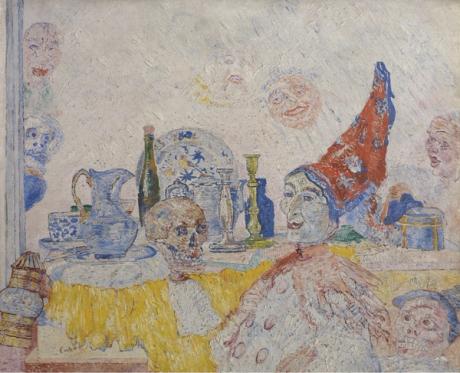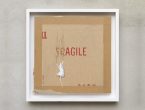Cosmic Call
2019 - Drawing & Print (Drawing & Print)
12:43 minutes
Angela Su
In the first part of Cosmic Call by Angela Su the voiceover proposes in a neutral, documentary-like tone, a series of stories to rethink the way we usually understand, justify, or place blame for epidemiological events. Comets carrying an infective bacterium are linked with the invasion of viruses—our current nemeses—coming from outer space. Second-century BCE medicinal writings correlated the appearance of 29 comets over 300 years with events including plague and drought. Other ways of thinking about diseases than those delineated by Enlightenment frameworks of science and progress are highlighted. In the second part of the video, the near-immutability of outbreak narratives and the character’s frustration at her inability to significantly transform them, forces the main character –Su herself–to take matters into her own hands. She has nurses inject her body with doses of the deadly viruses to become one with them, living with them rather than othering them. The facts and fiction woven together in Cosmic Call create an alternative understanding of epidemiological outbreaks and points to the danger of reducing all knowledge to scientific terms, showing the extent to which our reactions to illness are framed by different levels of fiction. Assembled from a variety of historical and imaginary sources in what seems to be a documentary, the work indeed brings forward all sorts of accusations, conspirations, fears, affinities, identifications and illusions, which culminate in a transformative, gothic action involving deliberate exposure to a series of viruses. Relevant worldwide, Cosmic Call also addresses issues that are specifically pertinent to Hong Kong, which is characterised by conditions–its high population density and mobility–that make it extremely vulnerable to disease outbreaks.
Angela Su’s practice is derived from her two divergent backgrounds–she received a degree in biochemistry in Canada before pursuing visual arts. Known for her intricate scientific drawings where delicacy of technique is contrasted with ambiguous and sometimes unsettling content, Angela Su combines in her works the analytical approach of a scientist with a deep sensitivity toward the felt, visceral experience. She connects her ideas through her imaginative drawings to this blending of science and alchemy, and recognizes the mutability or change, in species, whether human animal or the insect variety. Interested in science-fiction, medicine, and advanced computational technologies, her works (drawings, video, hair embroidery and installation) focus on the interrelations between our state of being and scientific technology, and more recently her mental and physical illness and social control.
Colors:
Related works sharing similar palette

© » KADIST
Daniel Gustav Cramer
2020David Gustav Cramer’s are composed of simple, descriptive texts accompanied by found photographs, letters or other materials...

© » KADIST
Alain Séchas
2006Coué 1 is an animated sculpture that hypnotically highlights the self-motivating leitmotiv of the ‘Coué Method’: “Every day, in every way, I’m getting better and better.”This is the mantra that is repeated by different male and female voices in the soundtrack – first in an incomprehensible painfully slow slur, becoming clear and speeding up into a drilling hilarious sounding high pitching spin, as if helium had been inhaled...

© » THEARTNEWSPER
Supreme court ruling concludes lengthy battle over Franz West estate Art market Museums & heritage Exhibitions Books Podcasts Columns Technology Adventures with Van Gogh Search Search Artist estates news Supreme court ruling concludes lengthy battle over Franz West estate The Austrian sculptor's art will go to his private foundation, represented by Gagosian, overturning previous decision granting ownership to West's widow and children Anny Shaw 18 December 2023 Share Franz West in his studio, 2009 © roessle A long-running inheritance row over the estate of Franz West, reportedly worth more than $50m, has finally been resolved after the Austrian supreme court last month concluded that all of the Austrian sculptor’s art should be donated to the Franz West Private Foundation, which is represented by Gagosian...

© » THE GUARDIAN
‘The more art I see, the broader my perspective gets’: a visual artist’s week with the National Art Pass | Me and my National Art Pass | The Guardian Skip to main content Skip to navigation Skip to navigation Paid content About Paid content is paid for and controlled by an advertiser and produced by the Guardian Labs team...

© » THEARTNEWSPER
James Ensor: series of anniversary shows to reveal ‘the man behind the mask’ Art market Museums & heritage Exhibitions Books Podcasts Columns Technology Adventures with Van Gogh Search Search Exhibitions news James Ensor: series of anniversary shows to reveal ‘the man behind the mask’ Belgium commemorates 75 years since the artist's death with a year-long season of exhibitions and events, often highlighting the lesser known aspects of his work Eddi Fiegel 15 December 2023 Share James Ensor, Pierrot and skeleton in a yellow robe (1893) Photo: Hugo Maertens The Belgian artist James Ensor may be easily recognisable for the macabre faces that so often feature in his works, but a major new season of exhibitions and events in his home country aims to reveal “the man behind the mask”...

© » KADIST
Jennifer Bornstein
1994Collectors’ Favorites is an episode of local cable program from the mid-1990s in which ordinary people were invited to present their personal collections—a concept that in many ways anticipates current reality TV shows and internet videos...

© » KADIST
Charles Avery
2012Since 2005, Charles Avery has devoted his practice to the perpetual description of a fictional island...

© » ARTNEWS RETROSPECTIVE
Mary Weatherford Revisits an ARTnews Profile of Joan Mitchell – ARTnews.com Skip to main content By Alex Greenberger Plus Icon Alex Greenberger Senior Editor, ARTnews View All September 4, 2020 10:27am ©ARTnews In 1957, art critic Irving Sandler paid a visit to the studio of painter Joan Mitchell , an Abstract Expressionist known for her brushy images capturing nature...

© » KADIST
Charles Gaines
1980To make his series Shadows (1980), Gaines subjected 20 potted plants to a uniform procedure...

© » KADIST
Gabriel Chaile
2019For the project Aguas calientes Gabriel Chaile exchanged silverware from three popular soup kitchens (mutual aid organizations to provide food for people in need) in Buenos Aires to brand new cooking utensils to shape his project...

© » KADIST
Roman Ondak
2003As the caption purposely admits, these drawings were made by friends of Ondák’s at home in Slovakia asked to interpret places he has journeyed to...

© » LENS CULTURE
Cultural Changes at the Coldest Place on Earth — A Photo Story from Yakutsk - Photographs by Alex Vasyliev | Essay by Marigold Warner | LensCulture Feature Cultural Changes at the Coldest Place on Earth — A Photo Story from Yakutsk Photographer Alexey Vasyliev offers an intimate look into the life and changing culture of the Evens, an indigenous tribe in his hometown of Yakutsk — one of the coldest places on Earth...

© » KADIST
Maria Fernanda Plata
2015Unraveling, or “unweaving” sections of fabric, Maria Fernanda Plata arrived at delicate and tenuous-looking forms, both ghostly and gentle...







